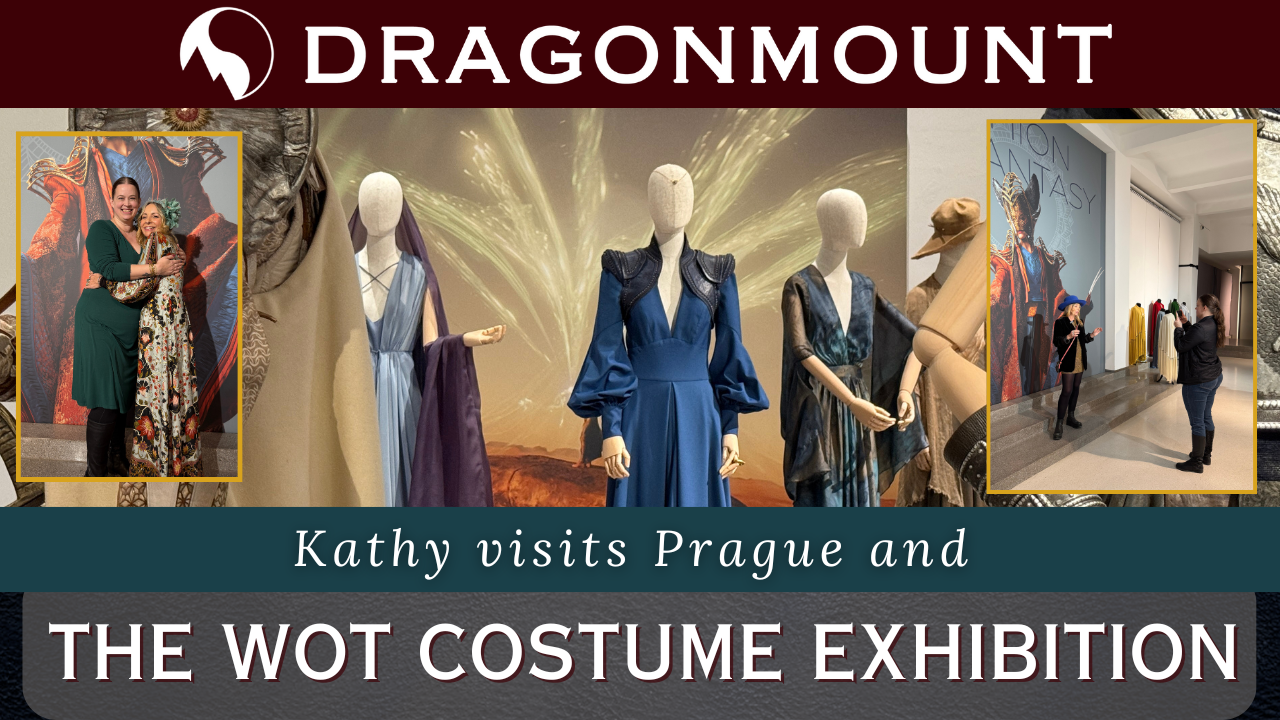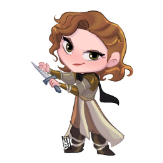News items
The Wheel of Time costume exhibition at Prague's Galerie Manes showcases over 80 breathtaking costumes, offering an unprecedented look at the intricate craftsmanship behind the show.
Read More...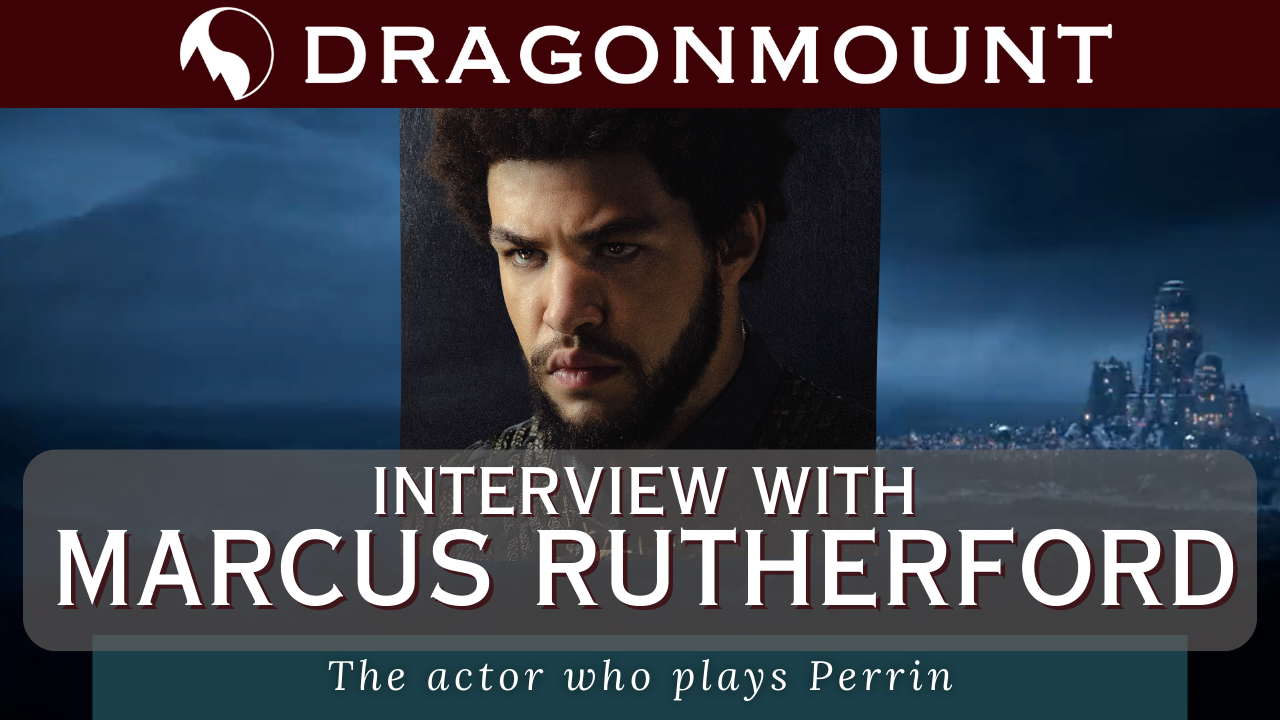
When Amazon asks if you want to talk to four cast members from The Wheel of Time on Prime Video, you drop everything and reschedule your day to make ten minutes for each one available. Now that the SAG-AFTRA strike has ended, the media is finally able to communicate with the cast, and it’s been so wonderful. I know how excited the actors have all been to talk with the fans as well! We were lucky enough to gather together questions to ask Ayoola Smart (Aviendha), Kate Fleetwood (Liandrin Guirale), Marcus Rutherford ( Perrin Aybara), and Dónal Finn (Mat Cauthon). These interviews will make you want to rewatch all the episodes of Season One and Season Two of The Wheel of Time on Prime Video…I know they did for me. Marcus Rutherford has such a soothing presence and was wonderful to take some time to talk to us! Here is a snippet of our interview with him. Dragonmount: You have had the opportunity to befriend some of the bestest boys and goodest girls, specifically the Best Supporting Actress Nom of our hearts, Ka Lupinka. How have those friendships strengthened and grown during S2 and do you have any stories about them that you can share? Marcus Rutherford: Yeah. It was amazing, man. I had a very kind of brief encounter in Season One, but I didn't really get to kind of work with the animals. And then Season Two… You kind of forget this is a real animal, man. It's like a real animal, look, it wants to do its own things. It's kind of like when you work with your horse and stuff, you can’t cheat it. The animal needs to want to kind of stay near you and work with you and listen to you and all those kind of things. It was insane. I think with that Czech wolf dog, they are sort of like a half breed, so it's not particularly easy to get them to like, you know, there was one scene for me that was really important. Where the makeup and effects built like this sort of “deer carcass,” that the wolves are kind of like eating and they (production) kind of just needed Hopper to stay next to me. It wasn't like on a lead or anything. She just had to sit there. And when you see all, these are the dogs eating, their natural instincts you think would be to follow. It was kind of like a scene that I could tell everyone was like (thinking), this is going to go wrong. We just put a load of meat in front of a dog, and its friends were eating… and yeah, it just stayed there instead for the whole scene. It was a really beautiful scene with Elyas and it was just one of those moments that was just so sweet, and I kind of needed the connection there, and you don't really want to have to think about, “Is the dog wandering off or is it not calling for the owner off camera or whatever?” And she just stayed there and she just looked at me at the little moment as a little look where he says, like his mate died too, and all this kind of stuff. And I think there were a lot of moments with that dog where I was just like, “You've made this really easy for me,” which is just like, really special, really special. It could have been, you know, it could've been really tricky. And she, um, she really trusted me. And I think, I think the owner, an animal handler named Maria was amazing. She (Maria) was just like, she (Ka Lupinka) doesn't really connect with people that easy. And it was special. And I think, you know, I think Rafe was kind of torn between like sort of big sort of visual effects kind of animals or like, you know, real animals. And of course you can get a bigger scale with some of those kind of things. But I think for an actual human connection, you just can't like you can with a real animal. I've had so many messages with people talking about their own animals. And I just, I just, I think that's the connection that it needed for, for the show. It needed to be a real bond, a real creature, a real thing in camera that people could connect with and understand with their own dogs when they sort of look at them after the episodes. DM: Season Two's journey for Perrin has ultimately been the battle between the Way of the Leaf and his desire to protect others. How did you prepare for a role that relied on so much internal struggle in such a visual medium? MR: Yeah, it's tricky because in the books you have these POVs that can get, especially for a character like Perrin, you get so in-depth with what he's thinking and everything, and then to translate that into a show with just 8 episodes…. is hard, man. It's really hard. And I think what was good about Season Two is he kind of gets thrown into a lot of positions that are quite challenging for him. You see it with… when he's with the Sheinarans or he's with Aviendha he's kind of like… There are kind of those lovely conversations that he's had with Ila and the Tuatha’an in Season One. You can kind of see that still surfacing. But it's becoming apparent he can't avoid violence at war, and it's kind of surrounding him and something that might be within him as well. But this idea that you can kind of just like turn away from it is becoming quite a difficult road to take. So I think with the introduction of the Seanchan and that kind of very, you know, horrible, horrific kind of culture in a way, in the terms of how they use violence and stuff. I think what was lovely about Season Two is that, for a character that isn't really saying everything that's going on his mind, you can kind of see him going through it. Being put in these situations that are hard for him and traumatic. That dichotomy between violence and being a pacifist in a way is still kind of put to a test really. It's not just a conversation around some wagons that you had in… Season One. He's getting dragged, but he's getting dragged around (literally)... I think that happens a lot in Season Two. DM: What scene from Season Two were you most excited for the audience to see? MR: I think…. in general or…? DM: Either way! However you answer the question is the perfect answer. MR: Um, I mean, ok. I remember (when I was) reading the book, I remember saying to somebody… to Maddie (Madeleine Madden), you know, I remember reading that book and actually feeling quite sick, reading it, like the way it is described is horrific. It's, it's really, really hard. I remember saying, like, you've got some hard stuff coming man. I've seen this one shot of her where she's sort of like crying. And I don’t know why, but I'm just like, I think it's beautiful. But I think in terms of the stuff, the scenes I loved, I really loved when he [Perrin] meets Aviendha. I think you needed to kind of isolate him away from the group a bit in order for him to grow. Like I said, you don't really have a lot of time, and we have to squeeze a lot into those episodes, and they do such a good job. And I think when you've got a lot of big characters who, you know, who’ve got their shoulders back, they're quite confident. I think they’ll naturally, you kind of speak and Perrin, he's probably thinking in the corner a little bit. So I think I'm putting him by himself and getting to meet someone who has such contrasting ideas and philosophies around violence, warfare, and fighting, I think, I think was lovely and I think Ayoola (Smart) was incredible. And I think that scene where he releases her from the cage, and they fight together, and even that little scene afterwards where he can't really gauge her humor like at the campfire or whatever… I think, I think that was a really nice part. DM: I know from speaking with the stunt team at Jordan Studios that you and the rest of the cast have worked to do as much of the stunts and fighting as you can yourself. How is your training, in particular, different from the others because of your use of an axe versus a sword or a shield? MR: What's really interesting with Perrin, in particular, is he's not really fighting to kill, or like I said (before), he’s still in this mode of like kind of defending himself and others and being thrust into these positions, whereas you kind of see some of the other characters, like Aviendha, she's just having fun. She’ll just go ham. So I think that was quite interesting. You kind of have to have a fighting technique that isn't particularly kind of like a bravado or showing your skill or your kind of like, a hunger for kind of violence in a way. It's kind of something that, it's really interesting, and I’ll talk too much, but it's really interesting seeing it develop, you know, going forward and all that kind of stuff and how it all changes. But I think it takes a lot to kind of show off his strength, but also his kind of resistance as well. For the full transcripts with the full conversation for this and the other interviews, sign up on our Patreon!
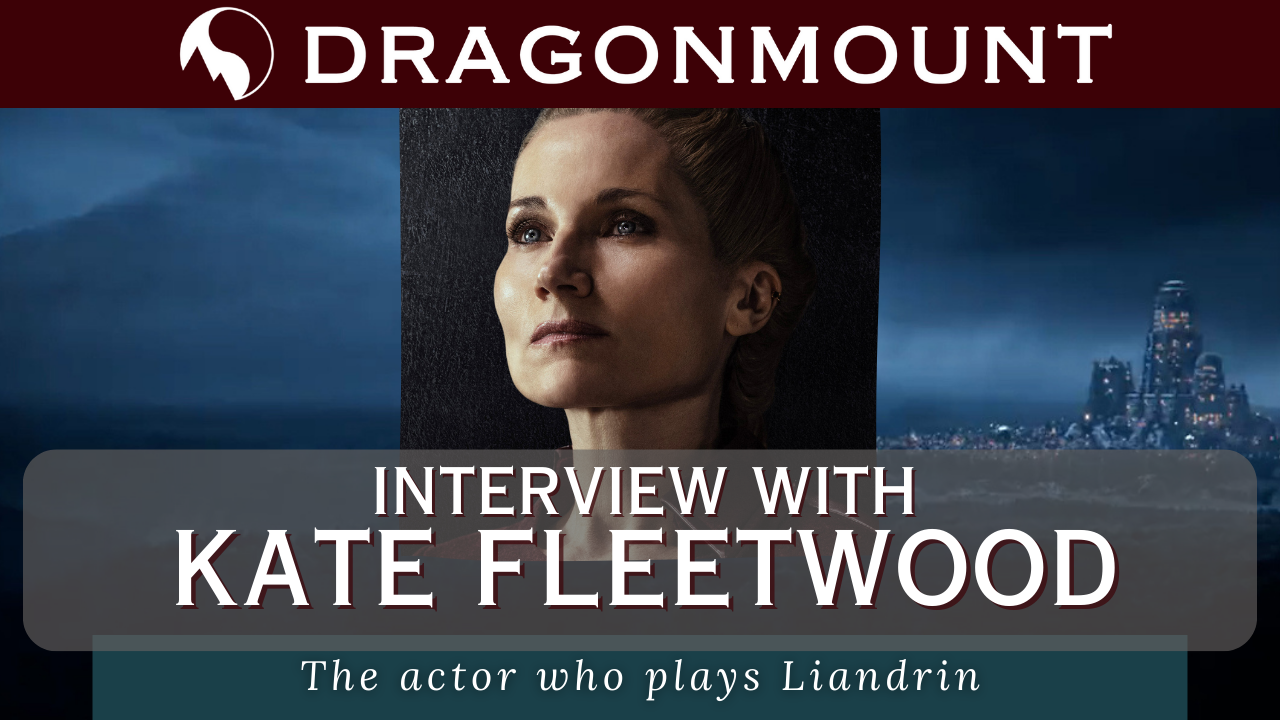
When Amazon asks if you want to talk to four cast members from The Wheel of Time on Prime Video, you drop everything and reschedule your day to make ten minutes for each one available. Now that the SAG-AFTRA strike has ended, the media is finally able to communicate with the cast, and it’s been so wonderful. I know how excited the actors have all been to talk with the fans as well! We were lucky enough to gather together questions to ask Ayoola Smart (Aviendha), Kate Fleetwood (Liandrin Guirale), Marcus Rutherford ( Perrin Aybara), and Dónal Finn (Mat Cauthon). These interviews will make you want to rewatch all the episodes of Season One and Season Two of The Wheel of Time on Prime Video…I know they did for me. Kate Fleetwood was just as amazing as the first time we were lucky enough to interview her. Here is a snippet from our interview with her. Dragonmount: Last year, when we spoke, you let us know how much fun you have with your castmates off-set and how much you just love to play. Did that continue with Season Two and the just-wrapped Season Three, and how did you add in all of the new cast members into that playtime? Kate Fleetwood: We always have a really nice time. We did karaoke and I mean, the boys and girls of a certain age are really good at going like waterskiing, things like that. But I don't do any of that. And I've got bad knees, and I like to get to that… but yeah, it is. And we’vehad so many new cast members, and again we've had loads this season as well and they're all international and that's, that's always the brilliant thing about Wheel of Time is that it's so broad. The breadth of people and the kind of people you get to play with is just brilliant. And I'm so looking forward to meeting some of the new characters this season. It’s just brilliant but we were still suffering a lot of COVID restrictions in Season Two, you know, and that was really tough because we couldn't see each other at all. You know, we were still eating little boxes in our rooms and not allowed to see or touch anybody. Here is just as a little bit of trivia on the scene where I'm within the way gate with the horses and the girls. When we were blocking that scene, our director took her mask off. And it's the first time I'd ever seen her face in three months. It was still really tough on everybody, you know? And we were being like, shut down a lot and having to stop. And so it was actually, it was tough enough to shoot that. And I think people sort of forget that we were still, we were still in a kind of COVID world while you're making something because of so many precautions. So it has been lovely this year. You know, we've been able to sit in tents together and eat and things like that on set and just like not have to just be shut away all the time. That, that's just been great. DM: Season One Liandrin’s chemistry with Moiraine was fantastic, and I think the, the amazing chemistry between Liandrin and Mat this season is really off the charts. You have chemistry with like inanimate objects, with just your presence. Is there something special that you do that allows for this incredible connection on screen, or is that just kind of your amazingness? KF: "It's just my amazingness.” No, haha… I think, I think I’m really, really touched that you say that. It's a really kind compliment. I mean, it's really genuine. I'm really genuinely touched by that. Thank you. DM: It's, it's so true. Like, it doesn't matter any time you're on screen. Just, I'm always just so excited to see how you're interacting with anything. I mean, with the horses, with, you know, I got that little look you did before you went through the gates after releasing Nyn like, I just think it's about being so present. KF: The thing I think I try and do, which might be the answer is, I don't know if it is the answer because I think it's quite hard for me to answer this. But when I think about playing, I'm always looking for the playfulness. It is always an opportunity to play everything, you know, like you say, you know, whether it's a cushion or a place or how you unlock a door, you know, every gesture or every motion or inflection in your voice you are as an actor. You've got, the words and the story and you've got your body and your voice and, you know, and that is your tool and that is your instrument, you know? And so you're looking for tone. And this is probably going to sound really pretentious, but you're always looking to how do you play this, and you play this instrument in this situation. And that can just be, you know, the look with a glance with it. But you embody and you, I mean, I just spend hours and hours on the set and I spend a lot of time prepping scenes. I just do a lot of work on it. It's like anything, you know, you just got to do, got to do it to work on it. You can't just turn up one night. I like to play at home, you know, I'll move the furniture back and, you know, and I'll play it, I'll play it, play it, and then something will just go *bing*. And then of course, you play with the other characters because you can't. But I'm always searching for other ways of telling story, and I think this really brilliant experience as a young actress, I was really lucky enough to play in the chorus, in a Western version of Medea with Fiona Shaw. She is in Harry Potter and Killing Eve and a lot of people would know her. I learned it from her that you got to be brave, you got to be playful, and you just got to keep true and you got to try things. You’ve got to experiment and play. I don’t know if it pays off but… DM: It definitely, it pays off. When you were filming Season One, did you know things that were going to be revealed in Season Two specifically, like your son? KF: No, no, no. But that’s the other thing that goes toward this playfulness is that you have to keep completely open. Of course I have to structure my performance because we, shoot a lot of time, not chronologically. So you do have to have some, constant awareness of, you know, the arc of everything. But it's part of the fun of playing is not knowing. And you have to be, you have to be open to that as an actor. You got to be open to change. You got to keep things moving and changing and shifting.You have to be always fluid-thinking because anything can happen. Lots of things happen in Season Three... yeah… they sat me down and were like, “This is what we are planning for you in Season Three.” I was, whoaa! Ok… DM: You have had some of the best wigs, intricate braid work and all of that. We're wondering which wig is your favorite and do you name them? KF: I don't (name them), it’s just sort of the great thing about the wigs, it gives you sort of this massive facelift, you know, because it's like they're suddenly like, *eeeee ahh.* No, but the wigs on the show…. I wish everybody could just go into those departments, the hair and makeup department. And the costume department and every department, actually. But when you go into that wig room, in the studio, that all lined up, you know, it's like what Davina and her team have done with the way the braiding is amazing. It's incredible. And they have people just doing it around the clock. You can walk in and then they'll go, we're just going to try a new wig on today and, they’ll just have four beautiful wigs. And then you try each one on and then you have to have your photograph taken and everyone decides which one's best and it’s a long process to choose to make. But yeah, I've got some pretty good wigs in Season Three, just saying. For the full transcripts with the full conversation for this and the other interviews, sign up on our Patreon!

When Amazon asks if you want to talk to four cast members from The Wheel of Time on Prime Video, you drop everything and reschedule your day to make ten minutes for each one available. Now that the SAG-AFTRA strike has ended, the media is finally able to communicate with the cast, and it’s been so wonderful. I know how excited the actors have all been to talk with the fans as well! We were lucky enough to gather together questions to ask Ayoola Smart (Aviendha), Kate Fleetwood (Liandrin Guirale), Marcus Rutherford ( Perrin Aybara), and Dónal Finn (Mat Cauthon). These interviews will make you want to rewatch all the episodes of Season One and Season Two of The Wheel of Time on Prime Video…I know they did for me. Dónal Finn was so charming and clearly excited to be a part of The Wheel of Time. Here’s a snippet of our interview with him. Dragonmount: So as most folks know, productions often do not film in sequence. And you came into Season Two as new to the cast and the crew, but your character had a lot of previous rapport. What was your first day on set like? Did they throw you right into battle scenes or did you get to vibe with Kate Fleetwood hanging out in your cell? Dónal Finn: I feel really, really lucky about my first days on set because, for me it was chronological and like, that's a bit of a blessing because like you said, it's not always that. But the first scenes that I shot on set were the first scenes where you are introduced to Mat, and that's in the cell in the White Tower, and it was with Kate. And then with Kae (Alexander, who plays Min). But I think the blessing was, you know, there were scenes that were all happening in one room. And in that case, like I admired her from afar, like as a someone who goes to the theater a lot in London. And so we and our brilliant director of that block, specifically Tom Napper, said, why don't we, you know, find a space within our studios and maybe just rehearse these scenes? And so we got to kind of imagine them and play the scenes as though, it was as though it was like for a theater. And like, that made me feel really relaxed because I was very familiar with that experience. And so it did put me at great ease. And I think there was, even though I didn't know Kate before those days, even the fact that I kind of like was such a huge admirer of the work that I'd seen her do and because she's so, so lovely and that quality that she has and Liandrin is like she can just turn on and then switch it off when they say cause. And so you can have great, great fun with her like on set that always puts us at ease. And Tom is also such a legend and was so accommodating to all of my questions and ideas for the character. Yeah, my…first days on set were like, really, really blissful. Even though, like with this, what's going on for the character in those scenes is not bliss. DM: This season almost has four different versions of Mat. You have the regular Mat, you have Mat from the Accepted test, you have the Mat high on the Ishy Tea and then Mat after blowing the Horn. How did your preparation for each of those scenes change? DF: I feel like there's a, you know, that there's like one Mat that gets just like, pushed into these different situations. So there's kind of a, there's a healthy kind of core understanding of the character. And then you just kind of go, he was in, you know, he's being pushed into this circumstance. He's been pushed into the challenges facing today with a different kind of approaches. I think all of them were, I think they all evolved like different things. You know, I'm, but I think, you know, Mat, blowing the horn, that felt like there was maybe two things about that that needed specific like time and effort, as in like there's the fight, there's the kind of, there's the language, there's the Old Tongue. And then, similarly as well, with Mat drinking Ishameal’s tea. It’s kind of getting into the skin of like or what would that be like. What is, what is it like in our, you know, relative worlds and, and what would that be like physically? What would that do to the body and with all their emotions as well, you know? In the second kind of chapters of Mat that you described, like they're still really challenging and emotional and you know you don't get some of those things for free. And so you're always trying to find a way to imagine, like, what is it like. In my own experience and what's helped me feel that way as well, and I might be, it might be music or might be, you know, it might be if he's in a good mood, it might be just like making sure I'm having like a really nice time on set or enjoying, you know, having fun with the people behind the camera. And just being present to be hopefully being playful with, with the other actor. DM: The stunt team at Jordan Studios said that you jumped all in for fighting lessons once you were cast. And they hinted at something I know fans have been desperate to see on screen that might be happening in Season Three. Obviously, you can't give anything away, but is there a particular skill or trick that you worked really hard for that you can share? DF: The guys are unbelievable, particularly Andre, who is kind of the, the guy who has taught me from the start. It's like the karate kid you know, like kind of watching him and learning. I kind of get a buzz every time they go….”so we're going to teach you this.” He might be talking to me, and he'd be spinning the staff around. And I'd say, well, what did you just do there? And he'd say, “That? Yeah. It's just like, we've got the stuff in your hand, Twirl it over here, and then you spin it, as you put it, behind your back, and then you pull it over here.” And I kind of go, yeah I don't know how to do that. What's that? And then so he'll kind of like, you know, I get a buzz off of learning at all on like, you know, but he, he is so good that I just stand back and watch him and kind of wait for him to do something cool and then say, okay, I don't know how to do that, show me how to do that. So I kind of feel sometimes that the tricks are kind of like, you know, a footballer because you go, God, that's like so impressive, but in a battle sense, in the sense of like actually being in a battle, that's like super impractical, you know? Like, well, how do you have the time to spin it round like your back, you know? So I think, you know, that speaks to Mat’s character as well, because I think he enjoys being good at this and kind of the flourish of it, you know? I feel so lucky that, you know, practical experience and journey with the show is that I'm learning how to do this, you know? So, sorry. I don't have a specific move. For the full transcripts with the full conversation for this and the other interviews, sign up on our Patreon!

This past weekend, the Wheel of Time community came together for Malkier Talks’ annual WoT-A-Holiday event, a 24-hour celebration filled with games, stories, and a united effort to make a difference via donations to the Lightweaver Foundation. Dragonmount had the honor of kicking off this fantastical journey, and what an incredible start it was! Our segment began at 8 PM Eastern with the fun filled "WoT A Quote" game show featuring the Wheel of Tones. Hosted by our very own Michael, and featuring contestants Thom, Crystal, and Kevin, the event was a wonderful start to the night. It was filled with a lot of laughter as our contestants read famous Wheel of Time quotes in a variety of tones – from overwhelmingly bored to absolutely furious to celebrity impersonations! The audience participation was strong. Viewers were guessing who said each quote and added as much detail as possible to set the scene- who was the character talking to, what were they doing, what book did this take place in, etc. We also had the pleasure of giving away $25 gift certificates to the Dragonmount store and some Wheel of Time bumper stickers. Congrats to LightBlindedFool and GnomeandGarden for being quick on the draw with their vast WoT knowledge and taking home our gift certificates! Rob, the runner of Malkier Talks and our event host, set an ambitious goal of £10K to support the Lightweaver Foundation, a charity established by Brandon and Emily Sanderson to provide basic needs to those who need them. Thanks to the generosity of our amazing community, the event raised over $10,000 (or £8103) which is the standard they shoot for each year. Not quite the stretch goal set this year, but an incredible achievement for 24 hours of fundraising and it will make a difference! Following our segment, the baton was passed to Talk’aran’rhiod, followed by The Wheel Reads, the Way of the Leaf and so many more content creators. Each brought their unique flair to the event, with activities like trivia, WoTionary, drinking games and collaborative drawing. The diversity of our community's creativity was truly on display. The Way of the Leaf hosted WoTionary, which included some blindfolded drawing and of course, puppets. Joe from tWoTcast and Skeeter drew a lovely holiday scene which included trollocs pulling a sleigh and a Christmas tree decked out with Foresaken themed ornaments. Shout out to DanaLou_Who who actively participated in all 24 hours of the event with NO SLEEP. A special highlight of the event was the unveiling of the art for the 2024 Snacc Warder Calendar. For every 1k raised, they unveiled another picture. It’s a year filled with photos of everyone’s favorite Snacc Warder, Taylor Napier, with re-created poses by various WoT content creators! There were prizes won throughout various segments, but what charity event would be complete without some big fancy prizes? These were won by raffle, based on donation amount. All four Secret Project books donated by Dragonsteel- Jerri Williams A Full Leatherbound collection of Dragonsteel books, donated by Dragonsteel- Jamie Borbon Recording donated by Kate Redding & Michael Kramer- Jay 123. The Eye of the World signed by the cast- Charlotte Edmonds There was a special prize for the person who donated the most money- Roofmistress Leigh-a. £470. She wins a giant canvas print of Rob Christianson’s Wheel of Time map, signed by a plethora of content creators who attended WoTCon. Congratulations to all! "The Wheel weaves as the Wheel wills", and this weekend it wove a beautiful story of camaraderie and charity. Until next year, may you always find water and shade.
.png.9a42769a4b5a5ad47828537850fb0d64.png)
Step into the captivating world of comic book artistry as we delve into an exclusive interview with Marcio Abreu, a highly talented and visionary comic book artist hailing from São Paulo, Brazil. Currently lending his artistic prowess to Dynamite Entertainment, Abreu is expanding The Wheel of Time adaptation into the comic book realm. Abreu's current project involves the illustrations for Dynamite's comic book adaptation of "The Great Hunt," written by Rik Hoskin. "The Dynamite series will continue its adaptations of The Wheel of Time series into comic books, following 2009's 'The Eye of the World' (now collected into a graphic novel by Tor Books), written by Chuck Dixon and illustrated by multiple artists." Join us as we explore Abreu's creative process, the challenges of adapting Robert Jordan's world into a visual medium, and the artist's perspective on character design and world-building. *This interview was conducted in Portuguese and later translated into English. Q: Did you have any familiarity with The Wheel of Time before? Or this was your first contact with it? A: No, none! I discovered it when I watched the series on Prime Video, and liked it right away. Q: How did you start the process? Did you base your illustrations on the other graphic novels, scripts, or some other material the publisher gave you? A: I relied on references from a website that Dynamite sent me (referring to the iconic Seamas Gallagher artwork). But I used an already published "The Eye of the World" comic to get to know some of the characters, and I watched the show again with a more discerning eye to capture the atmosphere. Q: What is your working process like? Tell me about how you develop the pages. A: I usually sketch loosely on A4 paper. I create small thumbnails for the pages, which helps me develop the narrative better. Then I redraw everything on A3 paper, without using a light table. Q: Regarding the character design, did you have any freedom, or are you following what was in the books? Or a middle ground? A: I had complete freedom, but I tried to follow what had already been drawn, so as not to deviate too much from what had already been published. But I always try to improve if possible! Q: What do you enjoy drawing the most so far? Creatures, a certain character, magic, or something else? A: Aaaaah, man, I love the creatures! I hope they appear a lot! But, everything is very cool. The detailed settings, period costumes, horses, magic, and the characters, in general, are very fun and challenging. Q: I saw on your profile that you make a lot of Conan art. Did you know that the author of The Wheel of Time began his fantasy writing career with Conan books? A: I didn't know! Woooooooow!!! I hope this is a good omen. Q: How is it different to adapt a nearly thousand-page book into the art of a graphic novel? A: Actually, everything comes already outlined in the script. My job is to draw it in a way that pleases a legion of fans from around the world. I hope to not disappoint! We look forward to seeing Abreu's artistic vision come to life on the pages, and we're sure that fans all around the world will appreciate the dedication and passion he is bringing to this project. We can't wait to follow the journey of The Wheel of Time through Marcio Abreu's hands! The first volume of "The Great Hunt" graphic novel adaptation is now available from Dynamite Comics.

The holidays are nearly here! Which means Dragonmount has rounded up some of our favorite gifts for fans of The Wheel of Time. We've again focused on artists and small businesses. You can check out last years guide here. The first gift folks should think about are the book themselves! We recommend picking up some copies from your favorite independent bookstore like Powells. You can also support the wonderful Wheel of Time conventions and get tickets for the 2024 events, like JordanCon in April 2024, WotCon in July 2024, and MalkierCon in September 2023 in Prague! Don't forget that another great gift is supporting your favorite creator over on Pateron. Now let's dive into the fun stuff - physical gifts! First up we have this great Mat inspired mug from The Road to Tar Valon ($25.99). There's also this fox pendant ($98.54) to ward off any Aes Sedai channelling. For Perrin fans there's a warm wolfbrother beanie ($22.00). The Bayle Domon shirt is $28 (aren't we glad he was in Season Two!?). The Wheel of Time Christmas ornament is $15. And this cute little ouroboros ring is $98, perfect for the inspiring Aes Sedai. Continuing with our artistic finds, this amazing shadowbox art ($85) comes in a few different themes: Rand, Mat, and Perrin. Badali has the rights to make Wheel of Time jewelry again, including this lovely Moiraine Kesiera ($93) inspired by the TV show on Prime Video. One of the stand out performances in Season Two is Natasha O'Keefe as Lanfear. Lanfear fans will love this Daughter of the Night T-shirt for $25.99. Map lovers will adore this maps inspired by the world of The Wheel of Time ($41.05). Stickers are always as a stocking stuffer, and Mat fans will appreciate this sticker with the ashandarei ($2). Many Wheel of Time fans began with reading physical books, so a leather corner bookmark ($25.99) is a great way to mark your place. Did you know Dragonmount has a merchandise store? You'll find this cool Heroes of the Horn t-shirt ($26) and other Dragonmount themed gifts! Another cool sticker for Aiel fans is the Water and Shade sticker ($4.49). You might recognize this ring as one similar to the one worn by channelers in the Age of Legends. It's MAM original for $89. You can personalize this set of WOT map puzzle coasters ($27.30+). Finally for those who love all the costume designs in Season Two, this Sashiko jacket ($352) uses the same techniques as the one Rand wore in Cairhien foregate. Don't forget to check out last years gift guide for more ideas and artists to support! Happy Holidays from Dragonmount!
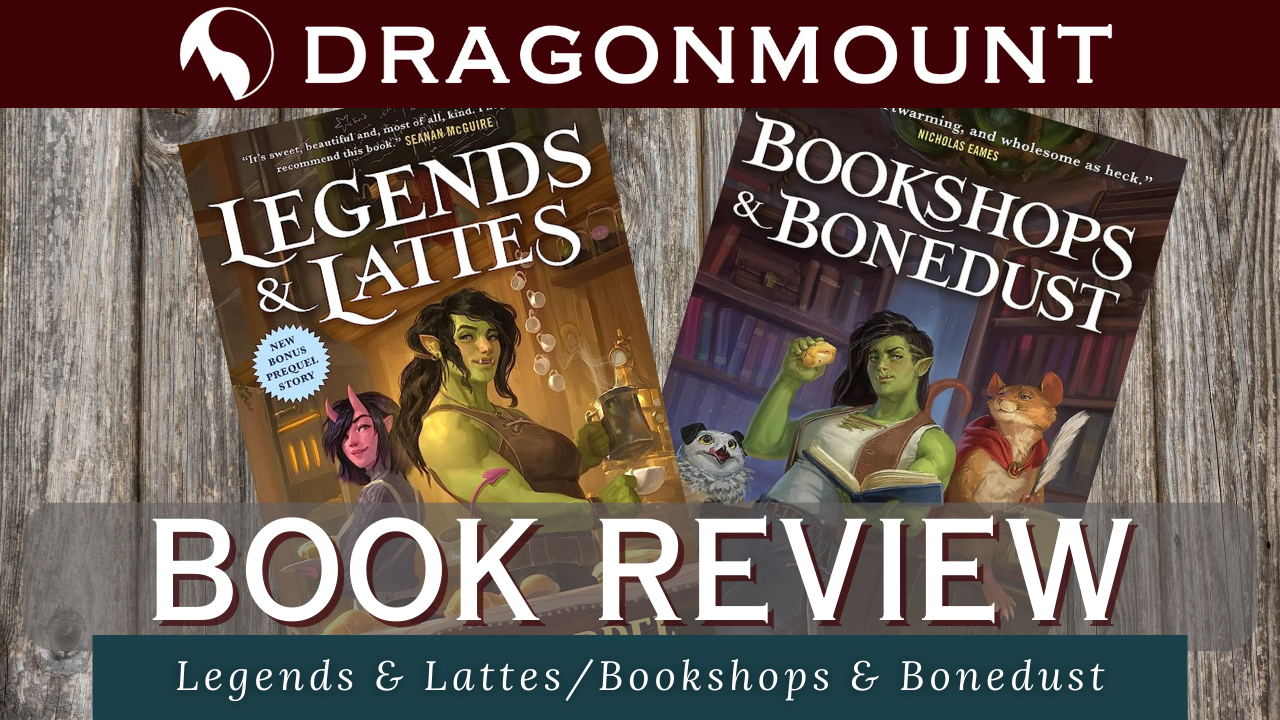
Aleksandra (Ola) Hill is a Polish-Canadian writer and the founder and publisher of khōréō, a Hugo-nominated and IGNYTE-winning magazine of speculative fiction by immigrant and diaspora writers. Her fiction has been published or is forthcoming in Analog Magazine, LeVar Burton Reads, Writer’s Digest, and others. Learn more at www.aleksandrahill.com # TL;DR: Legends & Lattes and its standalone prequel, Bookshops & Bonedust, live up to their promise of being novels of “high fantasy and low stakes.” These books are the literary equivalent of a warm hug: simple (but never trite) stories of individuals triumphing over the mundane and heroic that inspire the reader towards kindness at every turn. # I read Legends & Lattes in about two sittings a couple of weeks before it came out in November 2022—and then, well… life happened. We got a puppy; my first MFA thesis of the academic year was due two weeks after that; and then I was overwhelmed with work, gearing up for my second thesis of the academic year, and trying to handle the landshark that had taken up residence in our once-peaceful one-bedroom apartment. I thought of Legends & Lattes and the review I’d been meant to write for it every week since—not just out of the haunting of guilt that I’d still not gotten to it, but also out of how applicable it was. I found myself recommending it to anyone who mentioned that they’d been having a tough time—and, in the “post-COVID” years where it doesn’t ever truly feel like the pandemic is over and during which many other troubles have surfaced… well, that was pretty often. It’s with incredible pleasure that I learned I had the chance to review the second book set in this world—which came out just today, November 7, 2023. Because this review will cover two books, it’s divided into two sections: one for those who have not yet entered the world of Legends and Lattes, and one for those who want to know a bit more about Bookshops and Bonedust in particular. However, these are both standalone books, and you can start with whichever one tickles your fancy more. # Part 1: Legends and Lattes Legends & Lattes by Travis Baldree begins at the end. An orc by the name of Viv has just beaten what amounts to the Big Bad End Guy (BBEG) of her own adventure. And so… she decides to settle down and open a café in a city named Thune, where no one has heard of coffee (yet). She has a nest egg of gold that she’s saved up in her years of adventuring and a strong work ethic to make her dream a reality. It’s a far cry from her previous life, and a very different path than many of “her kind” take, as so many folks point out to her—but she’s determined to leave that past behind. What follows is the story of how the coffee shop comes into being. This is not a nail-biter of a book: the reader never truly worries that she will end up homeless and destitute—the stakes are never quite that high. Rather, the challenge is whether she will give up on her dream and whether she is willing to continue trusting herself and the path that she has chosen and, more importantly, whether she is willing to ask for help—or, more critically, accept when others offer the help she so willingly and unquestioningly gives to strangers. It is a book that asks whether a person can truly change, and whether they can find happiness in that change; it also understands that being entirely self-reliant can be the same thing as being selfish, and that trust and faith in others can be more terrifying than fighting monsters. Perhaps most importantly: this is a book that made me want to be kinder and more open to those around me. I live in New York City, where often, the biggest kindness you can give others is space and privacy to live their lives—and yet, while reading this book, I found myself longing to connect more closely to the neighbourhood I’d lived in for the past seven (now eight!) years. Thanks to our now year-old puppy, Virgil (pictured right), and his exuberant friendliness and insatiable curiosity about the world, we’ve been able to make our neighborhood more of a home than ever. I’d like to think Viv would adore his goofy, chaotic self. While I absolutely loved this book (as did many others—it was nominated for multiple awards and Baldree won the Astounding Award for Best New Writer in 2023), there are certain readers who will likely not enjoy it. In particular: if you are looking for higher stakes and extensive moments of tension—this book is not for you. Most challenges are vanquished almost as soon as they appear, which can give the feeling of a lot of stuff happening without much consequence (this is magically explained later in the novel, but that will not be satisfying for some, I presume!). The evolution of Viv’s café is also a big formulaic—from one type of coffee to two, from no pastries to one pastry to more, from tiny kitchen to large kitchen. If you’re looking for a book that goes into a realistic scenario of growing a food services business—this also probably isn’t for you (but I do highly recommend Anthony Bourdain’s Kitchen Confidential to scratch that particular itch!). However, this is the perfect book for you if you: are looking for comfort and coziness, want a queer, low-drama romance, and/or delight in descriptions of food. I recommend it most for those who feel deeply lonely: it’s the type of book that makes you want to reach out to those around you, and that may inspire you to ask for—and allow yourself to receive—the help that you need. Legends & Lattes is available in the DM eBook store. So is Bookshops & Bonedust! # Part 2: Bookshops and Bonedust Bookshops & Bonedust is Baldree’s sophomore novel. This one starts at the beginning: we see Viv, the retired adventurer and main character of Legends & Lattes, on her very first campaign with the mercenary group Rackam's Ravens. It’s almost her last, too: she’s injured by the henchman of the necromancer Varine and just barely survives. But survive she does—only for Rackam and company to leave her in the seaside town of Murk to recuperate. Stuck in a place that takes all of about ten minutes to see (according to the innkeeper) and still healing from a thigh wound that requires dreadful amounts of bedrest, Viv’s worried that she might go crazy from boredom before Rackam comes to fetch her on their way back from hunting Varine—if they come back for her at all. But while in Murk, Viv builds a community through her small acts of kindness. She befriends Fern, a rattakin who inherited her father’s slowly dying bookshop, her gryphet Potroas (for whom I would die)t, and a taciturn orc carpenter named Pitts. She also finds something more than friendship with Maylee, the local baker and a former adventurer herself. Readers of Legends & Lattes may also remember the name of Gallina, who appears in Bookshops & Bonedust as a young and somewhat annoying gnome desperate to be taken seriously enough to join a mercenary group. This book is also a great option for those who found Legends & Lattes a little bit too low-stakes but are on the lookout for cozy fantasy. It’s still definitely not a book that will set your heart racing at every turn of the page, but it does manage to keep a low level of concern throughout for what Varine the necromancer is up to, and has a greater antagonist arc than L&L managed. I appreciated how everything came together, both in the more mundane aspects of the plot as well as in the larger “BBEG” sense of the story. (With that being said, if you’re looking for a realistic Bookstore Simulator™, this isn’t the book for you—no mentions of consignment or returnability to be found here!) Ultimately, this book is about much more than adventure and magic. At its core, it’s about what it means to connect with others and to trust them; it also thrums with Baldree’s love for stories. Fern teaches Viv to love reading; she does so not with force or snobbery, but by trying to understand who Viv is and what will make her, not Fern, and not anyone else, happiest. Bookshops and Bonedust also considers the price of friendship and what it means to stay in a place temporarily, including what we owe those who care for us when we’re just passing through their lives. It’s a deeply touching book, and, in the end, encourages the reader to take chances and connect with the world around them, just like Legends & Lattes did. Also like Legends & Lattes, this is a book for those who want something cozy and comforting; who love books about books; who are looking for quiet queer romance; and—of course—who want to learn more about Viv, the wonderful orc of the first installment of this series. You can find both Legends & Lattes and Bookshops & Bonedust in the DM eBook store!
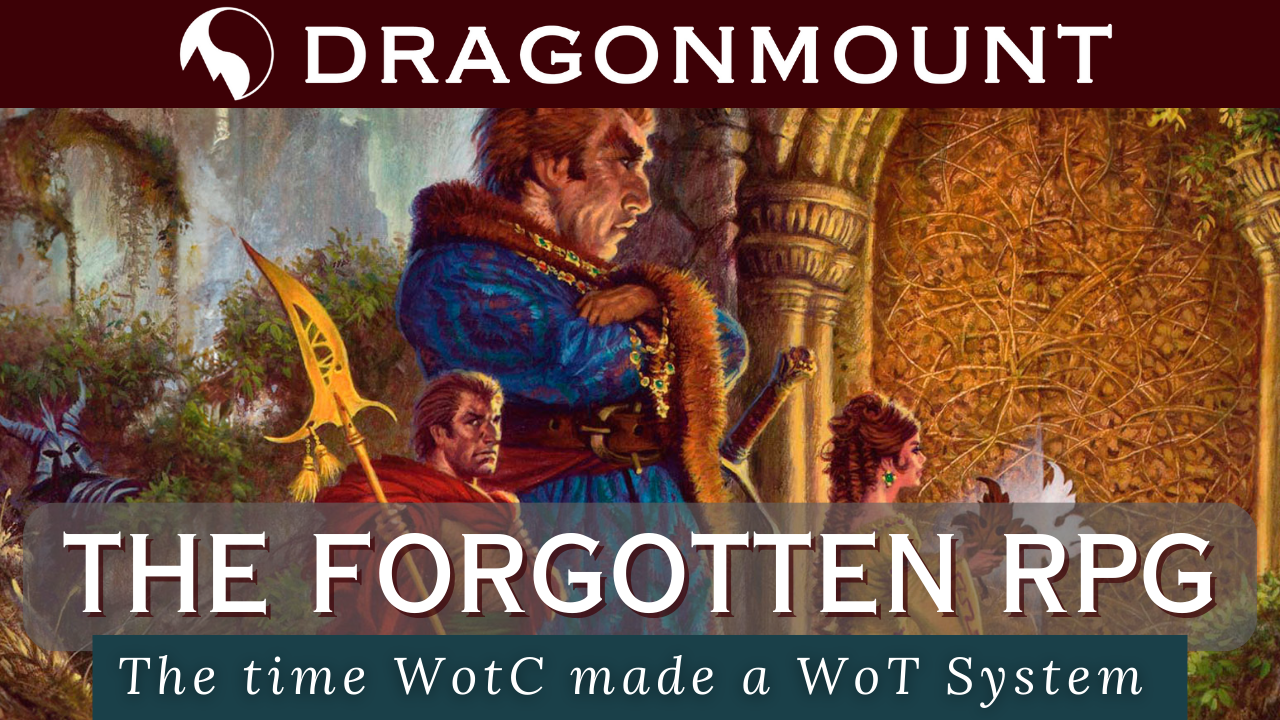
I Rolled a 20 on the Random Article table. Ah, the Wheel of Time, a tapestry of epic proportions spun by the brilliant Robert Jordan. It's a world we've all come to adore, one that has touched our souls with its grandeur. But I have never entered it so deeply as when I first played a RPG session set in the lands of the Dragon Reborn. Bienvenidos, my fellow travelers, to an article about the Wizards of the Coast Wheel of Time Roleplaying Game, a forgotten game that has recently resurfaced into my mind and that I believe both old aficionados and curious newcomers will find just as amusing as myself. Why write about it now? Personally, I find it intriguing to see how different people deal with Jordan's work, just as Rafe is doing and Brandon has done in the past. Some things in this book are just as interesting to analyze. Whether you're an old fan or a curious newcomer, the Wheel of Time RPG offers a chance to experience Jordan's world in a different way. Even if this way is through the lens of 2000s game designers not as well versed in Jordan’s universe as us diehard fans. As I revisit this unique RPG, I realize that some of the first images and art from the series I saw came from it, something I didn't remember at all. The first image of an Ogier that I experienced came from this book, and I only realize it now by revisiting it. Maybe that's also the case for some of you. This alone is another reason to go through it once more. Something I catch myself doing from time to time since I grabbed a copy of this book in Auckland when I was visiting my uncle. In my opinion, every adaptation is interesting. And it's even cooler to look at them after a new one comes out. No matter how different the media are, it's something that always catches my attention. As we can see on the internet every day: No one would do things the same way and everyone has their own perfect adaptation in mind. So why don't we collectively step into the minds of those who made this game over two decades ago? The Creators of the System. Crafted during the heyday of the D20 movement in tabletop RPGs, and at a time when fresh Wheel of Time content was in short supply, this publication undeniably satisfied the cravings of series enthusiasts. Nevertheless, it falls short in terms of the depth and replayability that could have transformed it from a mere novelty. The 300+-page rulebook featured new and original art throughout, bringing the world of The Wheel of Time to the tabletop. As a short book, it does its best at trying to condense the vast world of Robert Jordan into a few pages, sometimes making its depiction of the setting feel broad and lacking in detail. The game was based on the D20 rules system used by the third edition of Dungeons and Dragons, following a similar layout and format to the D&D core rulebooks despite all the setting differences. It was penned by a veteran designer team, including Charles Ryan, Steven Long, Christian Moore, and Owen K.C. Stephens. It's noteworthy that Robert Jordan himself provided a foreword for the game, revealing his own connection to the world of tabletop gaming and his excitement for the Wheel of Time RPG. The Wheel of Time RPG incorporated the talents of Darrell K. Sweet, the artist for the novels, who provided the cover artwork. It is so cool to see two additional paintings from him in the world of WoT that are not covers of the novels. It evokes a feeling of something familiar, but new at the same time, since not everyone has had contact with these illustrations. A large number of Wizards of the Coast artists contributed additional illustrations throughout the book, adding depth to the gaming experience. Ellisa Mitchell, known for providing cartographic services on the novels, created several new maps for the rulebook. Again, some of them that I had no idea were created specifically for this. D&D or not to be? This game made a lot of changes to the core D&D mechanics. The standard D&D character classes were replaced by new ones, such as Aiel spear-carriers, Armsman, Initiate (in the Aes Sedai or Asha'man), Noble, Wanderer, Wilder, and Woodsman. Multiclassing was also an option since this was a d20 system. Much like D&D 3rd Edition, feats played a significant role in character creation. Specialist feats for the use of the absolutely game breaking One Power were introduced, along with Feats that allowed players to replicate unique abilities from the books. The rulebook delved into the setting and history of The Wheel of Time, drawing from the novels that were published at the time. It offered somewhat comprehensive information, including the founding circumstances of countries like the Borderlands, Cairhien, Illian, Tarabon, and Tear during the War of the Hundred Years. But it went out of its way to avoid topics that would be discussed in future books written by Jordan. Later in his blog, Robert Jordan talked about the process of helping in the concept of the game, wanting to do more but with no time because of the books. And how he managed to avoid items The book featured re-drawn, full-color, and larger-scaled maps of cities like Ebou Dar, Caemlyn, Cairhien, and Tar Valon, adding a visual dimension to the gaming experience. An introductory adventure titled 'What Follows in Shadow' was included, set during the events of "The Eye of the World," offering players an immersive starting point for their own Wheel of Time adventures. It's always a challenge to create a game that takes place during the events of an ongoing story, but sometimes it's difficult to take agency away from the players because they're doing something that conflicts with the original canon or that wouldn't make sense in the world. The Lord of the Rings RPG, The One Ring, fails greatly in this aspect, where adventurers can only do the minimum without entering territory that threatens the original story of the books. Fortunately, this is not something that happens in the Wheel of Time RPG. Adventures offer options and stories that don't affect the book arcs and still have meaning for players. An expansion was created for the game called "The Prophecies of the Dragon," which is the only expansion to The Wheel of Time Roleplaying Game that was published. Again, cartography was handled by Ellisa Mitchell, and a new cover was produced by Darrell K. Sweet. Robert Jordan is listed as a creative consultant. Photos by: @manetheren_miniatures An invitation This is not a review (although if there is enough interest it might as well be in the future), but an invitation for fans to take a closer look at this material and appreciate its unique aspects. It's a journey through the past, a chance to rediscover something that may have been forgotten in the midst of new adaptations. As a fan, I felt compelled to revisit this piece of Wheel of Time history and share its significance. Even if my only conclusion is: Maybe it's time to try again. In the same vein, I plan to explore other forgotten media and adaptations related to the Wheel of Time universe, like for instance the PC first-person boomershooter reminiscent of Quake and any other turning of the wheel that I can lay my nerdy hands on. But what now? The recent television adaptation of The Wheel of Time series on Amazon Prime has reignited interest in this classic RPG. As fans of the TV series dive deeper into the lore, some are discovering the tabletop game and finding themselves drawn into the enchanting world of Aes Sedai and Trollocs. Which poses the question: Is it time for a new Wheel of Time Tabletop RPG? Some fans believe so. As part of the show's 1st and 2nd season promotional material, Prime Video Brazil conducted two different RPG sessions with YouTubers from the country. But these sessions were based on existing systems and seemed more like a patchwork than something designed for WoT. We also had fan adaptations for D&D 5e, but nothing official has been released since these two books in the early 2000s. Perhaps it's time for new materials to come. With numerous RPGs emerging every year and new design philosophies being introduced, such as in games like Mörk Borg, Knave, Shadowdark and many others, and with RPGs making a comeback in mainstream media with shows like Stranger Things, I see no reason not to have a new adaptation of Jordan's world for tabletops. Certainly, fans would love it, especially now that the hobby is more popular than ever.
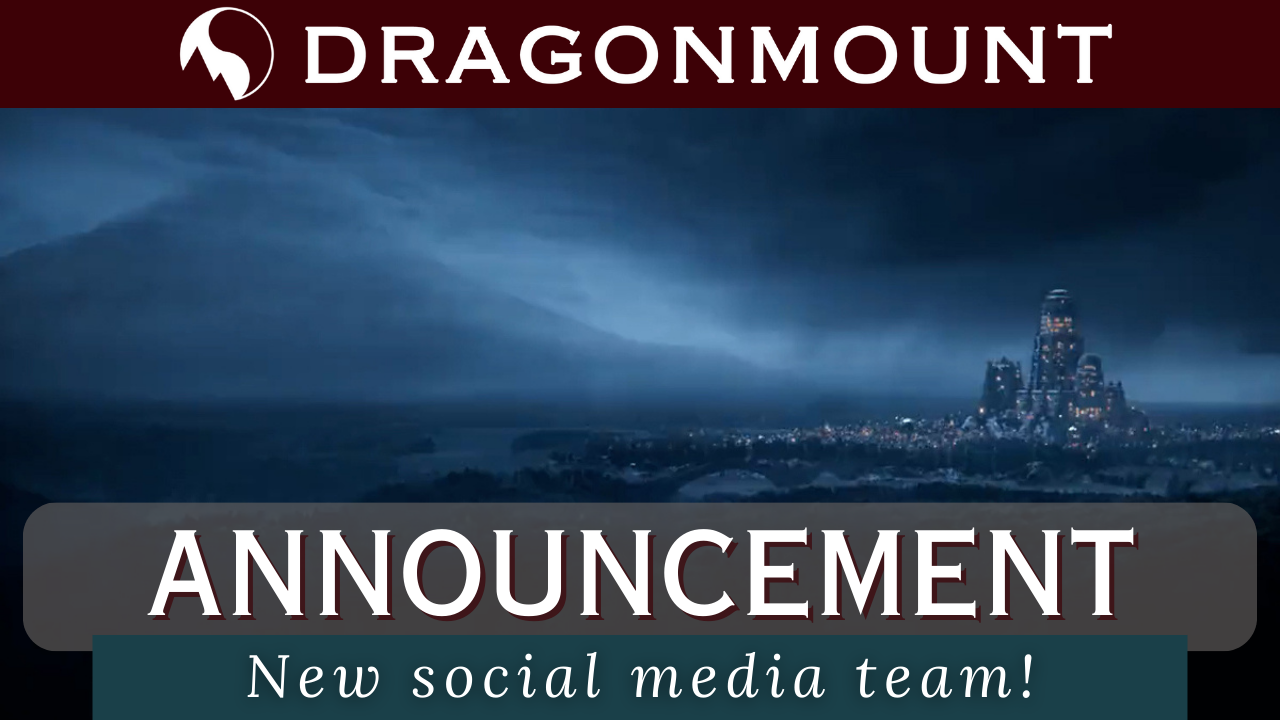
A message from the CEO: When I took over Dragonmount earlier this year, I knew I was in for a challenge. I had been helping founder Jason Denzel for years, but there is something different about being completely in charge! One of the bigger things I wanted to concentrate on after I got a handle on the day-to-day was to expand and enhance our coverage. Social Media is a huge part of the Wheel of Time community, and I knew we needed to get better at it, but I also wanted to put additional thought and energy into our longer-lasting information. Our news blogs and email newsletters have become very reactionary, and I wanted to get some more opportunities for fuller forms of text that will have a lasting legacy on our history. In order to do that, I knew I would need some additional help. We have a fantastic team at Dragonmount, full of passionate people, but I knew we would need some people who were concentrating on the writing aspect and knew their stuff when it came to social media as well. So I started a search. At first, I was worried that no one would be interested. Concerned that if no one applied, we’d be forced to keep going with the team we had and try to make it work. Quickly, the opposite problem began to occur. As each day passed, more and more people applied, and I started realizing that we would have a difficult time picking the right person. The long, drawn-out process felt like overkill for what is ultimately a passion project, volunteering with a small payment as a cherry on top, but as time went on, I realized how incredible this option was. I had a plethora of absolutely incredible humans to talk to and find the right individuals. Because as I got deeper into the process, I realized I couldn’t pick just one. And so it is with supreme joy and pride that I announce our new Social Media Team for Dragonmount. Thank you to Erin, Grace, Humberto, Kevin, Michael, and Rita for accepting the offer to come and play with us on the Slopes of Dragonmount. We’re so happy you’ve joined us! Kathy Campbell Erin A dedicated consumer of knowledge, Erin DeSimone wears many hats in her life. She holds MBA and PMP credentials, and serves as a Program Manager in her day job, putting her organizational skills (and spreadsheet wizardry) to use. After discovering the Wheel of Time in her college years, Erin became a member of the fandom and has become increasingly involved over time. When she's not immersed in something Wheel of Time related (or at Disney World), she's a Dungeon Master, crafting narratives that might even intrigue Verin Sedai herself. Grace Grace is a licensed mental health counselor who believes in the healing power of found family in fantasy novels and IRL. Also known as Bain & Chiad, Grace has been reading The Wheel of Time since 1998, when she and her high school sweetheart dressed up as Elayne and Rand for Halloween. She fell in love with present-day WoT fandom and was inducted into the Far Dareis Mai in 2019. She is the writer of Maidens’ List and a co-host of The Light’s Work and Three Fold Talk. Kevin Kevin is a business analyst with a passion for comedy, analyzing patterns, and The Wheel of Time. Kevin started The Wheel of Time in 2015 on a whim after an unrelated podcast mentioned it a few times, but didn’t find his way fully into the fandom until April 2022. Since then, Kevin has become infamous for his creations using trollocs, looney theories, and probably not being the Tweeter of Chaos. Kevin is also known as KEVIN, when providing comedic relief/discomfort on Twitter (@GradeKangusBeef), chatting with friends on The Kevin Podcast, and more recently, causing trouble as a cohost on Tar Valon After Dark. Rita Rita is a 20-year-old university student from Portugal passionate about fantasy, social sciences, and The Wheel of Time. Her sister introduced Rita to the Wheel of Time books when she was 16. After finishing the last book, Rita joined the fandom in July 2021 with the creation of her Twitter/X account. Currently, Rita, also known as Maiden of the Spear (@maiden_of_spear), shares her passion for the TV show, the books, and her love for Mat Cauthon (The last being what she's most known for in the fandom) with the community on a daily basis. Humberto Humberto Tramujas is a narrative concept developer with a creative vision and storytelling focus. He centers his work on creative writing, narrative, and direction across multiple media. Humberto has been working with a narrative for tabletop RPGs and social media work involving Social Cause Awareness themes and Geek subjects. Humberto started reading Wheel of Time in 2014 when the first books were released in Brazil. Michael Michael is a geologist and science communicator living in Colorado. He enjoys finding connecting narratives that bring relatively niche subjects to the public interest, whether that is geology or multi-volume fantasy series. Michael first read Wheel of Time in 2002 when the YA targeted From The Two Rivers and To The Blight releases of Eye of the World came out. He found Dragonmount shortly after, via a dial-up Internet connection, when searching for information about the upcoming Crossroads of Twilight.
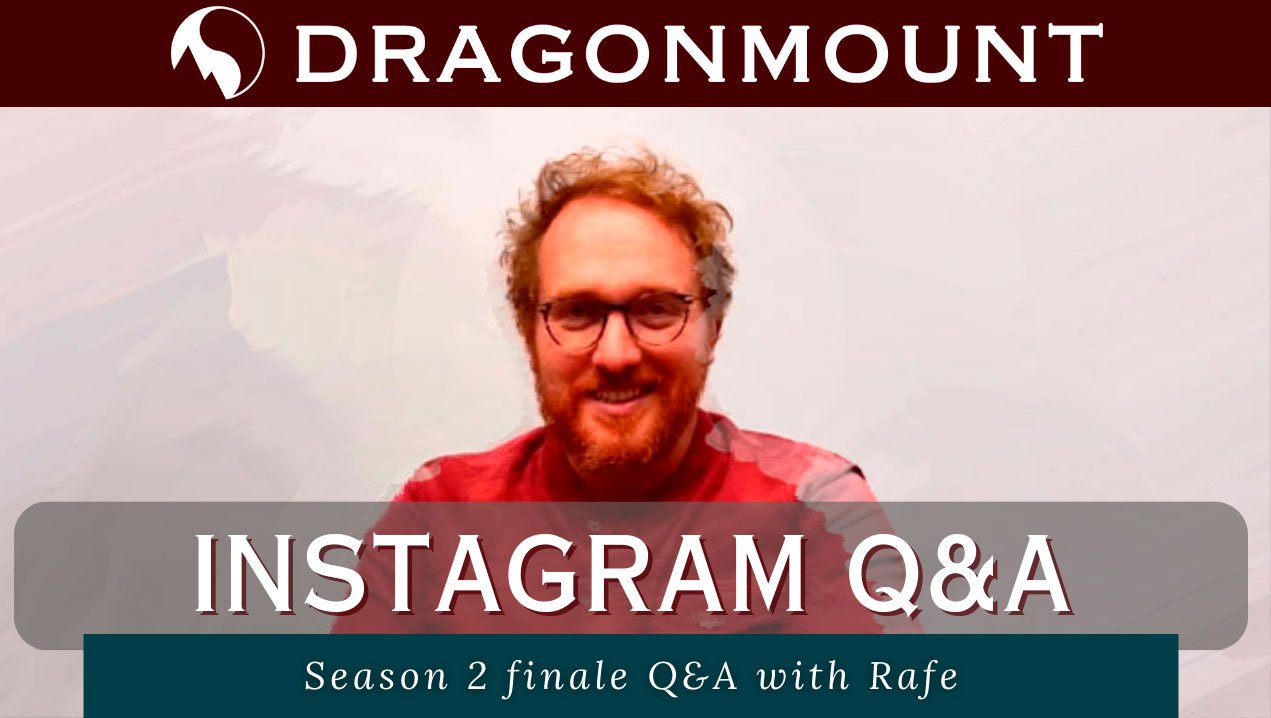
The week of The Wheel of Time Season Two's mind-blowing season finale, showrunner Rafe Judkins graced fans with a spoiler-free Instagram Q&A session. This casual tête-à-tête was a much-needed treat, especially since Rafe had been incommunicado during the strike. But fear not, my fellow WoT aficionados, because following a hard-fought agreement, Rafe has made a triumphant return to the heart of the Wheel of Time community. During this virtual Q&A, Rafe tackled six questions asked by the community posted on the official Wheel of Time Instagram account. His responses danced between behind-the-scenes anecdotes and personal favorites. Rafe started with some interesting tidbits about Season Two. He discussed the significant risks and rewards, particularly mentioning the beach locations in Morocco ”where no one had shot a TV show or movie before”, He explained the challenge these locations presented and how rewarding it was to see them on screen. When quizzed about his favorite character introduction in Season Two, Rafe quipped, “I can't decide between Elayne, Aviendha, and Verin”, making us feel like we're all in the same boat with all these fantastic additions to the show. Rafe even hinted at an Easter egg related to “an incredibly important weave in Episode 7” that allows channelers to travel long distances. We certainly will see more of that in the future! Halloween is creeping up on us. Rafe couldn't choose a favorite costume from the show, but he confessed, "If I were to go as someone for Halloween, it would probably be High Lady Suroth." When asked about the outstanding performance of Hopper, Rafe praised Ka Lapinka, the wolf responsible for bringing the pupper to life. “She does something incredibly impressive in Episode 8 that is not CGI”. We know now that he was talking about that heartbreaking death scene. I know wolves are supposed to be scary, but I would love to pet Hopper. Rafe concluded by hinting at his favorite moment from the Season Two finale but refrained from sharing further details to avoid spoilers. He hinted "a certain moment with Mat Cauthon and a musical instrument." For the full Q&A experience and more of Rafe's quips and secrets, head to The Wheel of Time's Instagram account.
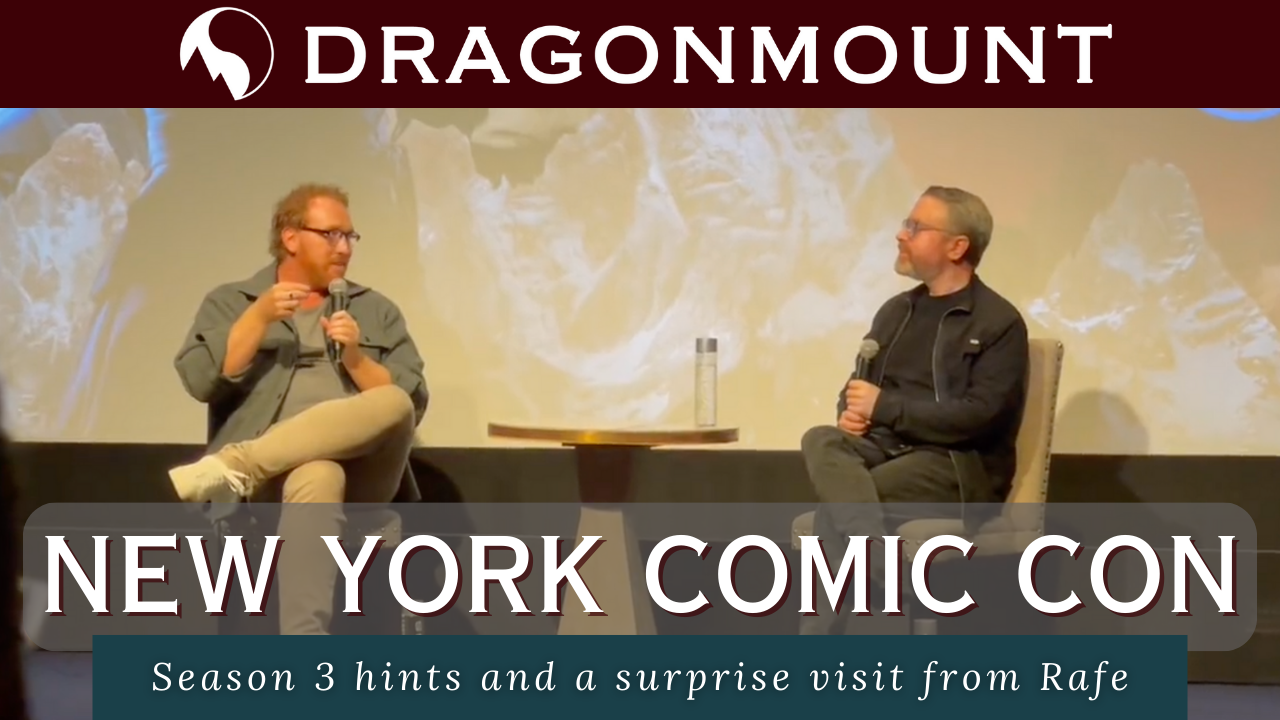
Coming hot on the heels of the epic Season Two finale just over one week ago, The Wheel of Time showrunner Rafe Judkins made two surprise appearances in NYC this weekend, bringing exciting Season Three news to delighted WoT fans in the Big Apple. His first appearance was at New York Comic Con 2023 on Saturday afternoon during the Prime Video Presents: The Power of Prime panel. Judkins appeared again on Sunday to introduce a special in-theater screening of the Season Two finale at the Whitby Hotel. The charismatic showrunner also stayed after the screening to participate in a Q&A about Season Two with television critic Sean T. Collins. On Sunday, during the post-screening Q&A, Judkins pleased Ingtar fans everywhere by teasing a Season Two deleted scene revealing that Ingtar is, in fact, a Darkfriend. He also shared that Season Three would be a big one for Rand and Perrin and that the Moghedien scenes are “to die for.” Judkins confirmed the Aiel Waste as a filming location for Season Three and teased other iconic Book Four locations, including “tropical” Tanchico and the Two Rivers (already lightly hinted at by a screaming Dain Bornhald in Episode 8). Most surprisingly, Judkins shared that Season Three will feature the Sea Folk, who will show viewers “new versions” of channeling in other cultures. At NYCC, Judkins confirmed that Season Three of The Wheel of Time will focus “on one book” (Book Four, The Shadow Rising). He also teased the casting of “a Forsaken you have not seen yet,” noting that he enjoys reading the “very serious commentary online” about which of the Forsaken will appear in the show. Judkins then promised a visit to Rhuidean and an exploration of Dreamwalking “with the Aiel,” which all but guarantees the appearance of Wise Ones in Season Three. Finally, after praising Kate Fleetwood’s performance, Judkins shared that viewers will find out at the very beginning of Season Three “what Liandrin’s been up to.” The showrunner also spoke about the “magic” of filming The Wheel of Time, describing two favorite moments from Season Two: Rosamund Pike “channeling fire itself” on a Moroccan beach at sunset, and Dónal Finn sharing that he’d learned of his casting as Mat while standing on the very same wall in Essaouira where he blew the Horn of Valere in Episode 8. The conversation with Judkins came at the end of The Wheel of Time portion of the NYCC Prime Video panel, which focused primarily on visual effects in Season Two, opening with a NYCC-exclusive VFX highlight reel for in-person ticket holders. The panelists, moderated by Damian Holbrook of TV Guide Magazine, included executive producer Marigo Kehoe, VFX supervisor Andy Scrase, and VFX producer Brian Shows. Highlights from the VFX discussion included Scrase’s passionate description of his process for reinventing the look of channeling in Season Two, with the goal of making it look more “organic” and “thread-like,” with specific details woven into each element beyond just the difference in color: sparks when channeling Fire, water droplets for Water, and distorted ripples for Air. Kehoe echoed her appreciation for the meticulous VFX work on channeling, in particular during the “novice kitchen scene.” Shar from the podcast WOT in Color attended the screening and shared the full Episode 8 discussion with us: Grace is a licensed mental health counselor who believes in the healing power of found family in fantasy novels and IRL. Also known as Bain & Chiad, Grace has been reading The Wheel of Time since 1998, when she and her high school sweetheart dressed up as Elayne and Rand for Halloween. She fell in love with present-day WoT fandom and was inducted into the Far Dareis Mai in 2019. She is the writer of Maidens’ List and a cohost of The Light’s Work and Three Fold Talk.

Showrunner Rafe Judkins wasted no time after the WGA strike ended before coming back to #TwitterOfTime with the perfect post: He then answered a ton of questions for fans. Book consultant Sarah Nakamura also answered some detailed questions. Let’s start off with Rafe’s general praise for the writers, actor and crew for Season Two. Rafe addressed the many challenges the team faced between COVID and the writers and actors strikes. Rafe and Sarah answered some questions about the incredible episode 6: Eyes without Pity, and the rest of episodes in Season Two. The Wheel of Time story contains thousands of characters and are played by incredible actors in the TV show. Rafe answered quite a few questions about our favorite characters for the light and for the dark. We will never forget “Steve” from Season One, who ended up being left on the cutting room floor, but became a classic meme for the fandom. Questions about characters for the Light: And as the Pattern must have balance, so must the light be balanced with dark and we have questions about Forsaken & Dark Friends: The next series of questions are deep diving into some of the changes regarding the elaborate magic system: channeling. Lots of book fans have questions about just how channeling works in the TV show since it’s different than in the books. Book consultant & expert Sarah Nakamura took on many of these questions. WOT Origins was much praised by fans for Season One, and unfortunately we haven’t seen the last two episodes of the first batch, and there are none for Season Two. It doesn’t look like we’ll be getting any more. Finally let’s take a look at questions about Season Three and Beyond: That’s a wrap on all the Q&A from Twitter last week! Make sure you tune in this week for the Season Two finale of The Wheel of Time!! What did you all think of Rafe’s answers? Isn’t it nice to have him back!? Let us know what answer most surprised you in the comments below. Also don’t forget to tune into Dragonmount ReWOTch every Monday over on Youtube and Twitch.



